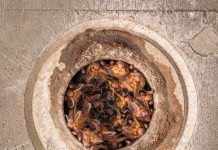The most perchlorate-contaminated private well in Morgan Hill
will soon pump clean water.
The most perchlorate-contaminated private well in Morgan Hill will soon pump clean water.
By March 1, the well located at U-Save Rockery on Railroad Avenue will receive one of the first ion-exchange well-head treatment systems to be used on a private well anywhere. The well is just down the road from the Olin Corp.’s former road-flare factory that was responsible for the contamination.
The U-Save Rockery well is also near the city’s Tennant well that had an ion-exchange treatment system installed last October. The Tennant well was off-line for more than two years because its perchlorate levels exceeded the 4 parts per billion level at which the City Council ordered wells off-line. It joined the Nordstrom well, that has had such a system since the spring of 2004.
Treating perchlorate-tainted water was almost the only option for the city because, having two large-producing wells off-line would cause serious water shortages during the summer.
The Rockery well also serves an apartment on Railroad Avenue. Vernon Isbell, who has lived on the property since 1968, said she’s not entirely convinced her water will be safe to drink, but happy that she may soon be free of perchlorate.
“We’ve probably never had clean water here,” Isbell said. “I’m nervous, but I’m pleased it’s happening as fast as it is because they said it would take years, if it happened ever.”
Isbell has received bottled water from Olin since the contamination was discovered in 2003. She said she’s never worried about bathing in the water that has consistently tested for perchlorate in excess of 100 parts per billion, but has always worried about the five feral cats she cares for. The cats also have been drinking bottled water.
The system that will be installed later this month is known as a perchlorate-selective ion exchange system, which means it removes only perchlorate from the water. In an ion-exchange system, water is pumped through the well and into resin-filled canisters, where the perchlorate is captured. When full, the canisters are drained and the spent resin is burned as fuel.
The system is a miniaturized version of the systems in place on four municipal wells in Morgan Hill and San Martin. Those wells have permits from the California Department of Health Services, but the DHS has not yet certified the system for private well use.
Perchlorate, a salt that can inhibit thyroid functions in humans, has been found in more than 450 water supply wells in an 18-square-mile area south through San Martin to the north and east of Gilroy.
Tom Mohr, the perchlorate project manager for the Santa Clara Valley Water District, said Olin is a pioneer in the use of ion-exchange treatment on private wells. He said that each well requires a uniquely designed system, and that the typical well owner’s lack of knowledge about their wells added to Olin’s burden.
“Olin is finding out all the tricks of this solution as it goes along,” Mohr said. “Having to test each well adds a lot of cost and a lot of time. We’ve been looking forward to this and we’re confident Olin is going about this in the right way.”
The certification process that began more than a year ago has stalled for reasons that are not clear. Water District Project Manager Tracy Hemmeter said that the agency has had trouble delineating a certification procedure.
“We simply don’t know where they are in the process,” Hemmeter said. “We certainly need to have better coordination with the DHS and see what we can do to get the process moving forward.”
A DHS spokesman was not able to say when the agency would certify ion-exchange for private wells. The DHS has certified reverse osmosis treatment systems, but Olin project manager Rick McClure said that the ion-exchange method is preferable because it works faster and doesn’t waste water. Reverse osmosis requires at least four gallons of water to get one usable gallon of water.
Olin will continue to provide bottled water until the treatment system is certified. In the meantime, it will install an additional three systems on the most-polluted wells to comply with a directive from the Central Coast Regional Water Board, which is overseeing the cleanup.
The regional board has issued three separate orders to Olin. The first requires the company to provide water for residents whose well water tests at or above 4 parts per billion. In December, the regional board directed Olin to prove that it is not responsible for perchlorate contamination north of the factory site, and, in late January, the board issued a final cleanup order. That order calls for Olin to declare how it will clean the perchlorate, and to what levels, next year. McClure said the number of well-treatments the company ultimately installs depends on the final cleanup plan.
The Morgan Hill City Council is displeased with the regional board’s second order, wanting the direction to be more emphatic. Since most of the city’s occasionally polluted wells are in the northeast plume, it is important that Olin take responsibility for the contamination and reimburse the city for costs estimated to reach $4 million through 2007, city officials have said.
Olin will soon have sent the city checks totaling $780,000 to replace the Tennant well but nothing toward the city’s other perchlorate-related costs.
Matt King covers Santa Clara County for The Dispatch. He can be reached at 847-7240 or mk***@************ch.com/
Staff Writer Carol Holzgrafe contributed to this story.







